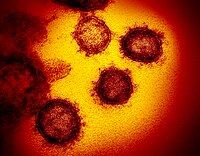
Photo from wikipedia
COVID-19, the respiratory infection caused by the novel coronavirus SARS-CoV-2, presents a clinical picture consistent with the dysregulation of many of the pathways mediated by the metalloprotease ADAM17. ADAM17 is… Click to show full abstract
COVID-19, the respiratory infection caused by the novel coronavirus SARS-CoV-2, presents a clinical picture consistent with the dysregulation of many of the pathways mediated by the metalloprotease ADAM17. ADAM17 is a sheddase that plays a key role in the modulation of ACE2, the receptor which also functions as the point of attachment leading to cell entry by the virus. This work investigates the possibility that ADAM17 dysregulation and attachment of the SARS-CoV-2 receptor are linked events, with the latter causing the former. Tetraspanins, the transmembrane proteins that function as scaffolds for the construction of viral entry platforms, are mooted as key components in this connection.
Journal Title: Biochemical and Biophysical Research Communications
Year Published: 2022
Link to full text (if available)
Share on Social Media: Sign Up to like & get
recommendations!